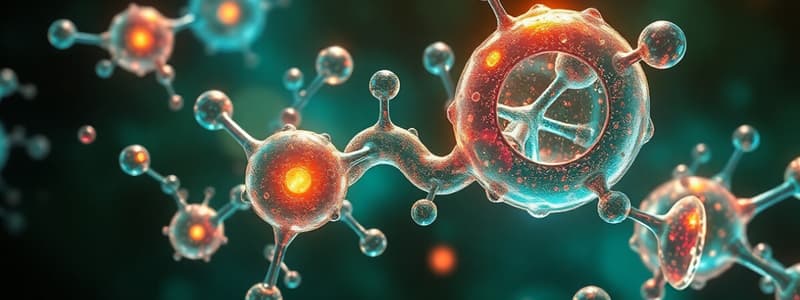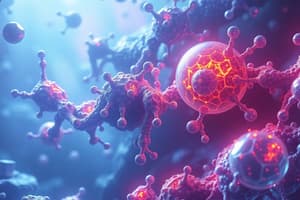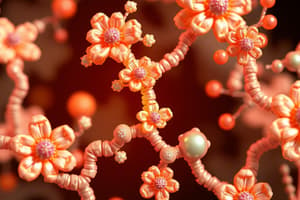Podcast
Questions and Answers
What are enzymes?
What are enzymes?
Biological protein catalysts that increase the rate of reaction.
Which type of enzyme catalyzes oxidation-reduction reactions?
Which type of enzyme catalyzes oxidation-reduction reactions?
- Hydrolase
- Oxidoreductase (correct)
- Transferase
- Lyase
Enzymes that catalyze hydrolysis of a bond by addition of water are called ______.
Enzymes that catalyze hydrolysis of a bond by addition of water are called ______.
Hydrolases
What does the term 'isomerase' refer to?
What does the term 'isomerase' refer to?
Ligases catalyze bond formation without any requirements for ATP.
Ligases catalyze bond formation without any requirements for ATP.
Which of the following is a coenzyme that carries hydrogen?
Which of the following is a coenzyme that carries hydrogen?
What are isoenzymes?
What are isoenzymes?
The region on the enzyme where catalysis occurs is called the ______.
The region on the enzyme where catalysis occurs is called the ______.
What is the purpose of allosteric effectors?
What is the purpose of allosteric effectors?
Flashcards
Enzyme
Enzyme
A biological protein catalyst that speeds up chemical reactions in living organisms.
Enzyme Classification: Oxidoreductase
Enzyme Classification: Oxidoreductase
Enzymes that catalyze oxidation-reduction reactions (transferring electrons).
Enzyme Classification: Transferase
Enzyme Classification: Transferase
Enzymes that catalyze the transfer of functional groups between molecules.
Enzyme Classification: Hydrolase
Enzyme Classification: Hydrolase
Signup and view all the flashcards
Enzyme Classification: Lyase
Enzyme Classification: Lyase
Signup and view all the flashcards
Enzyme Classification: Isomerase
Enzyme Classification: Isomerase
Signup and view all the flashcards
Active Site
Active Site
Signup and view all the flashcards
Induced Fit Model
Induced Fit Model
Signup and view all the flashcards
Allosteric Effectors
Allosteric Effectors
Signup and view all the flashcards
Enzyme Regulation: Feedback Inhibition
Enzyme Regulation: Feedback Inhibition
Signup and view all the flashcards
Study Notes
Enzyme Definitions and Classifications
- Enzymes are biological protein catalysts that increase the rate of biochemical reactions.
- They are proteins (or sometimes ribozymes, which are RNA).
- Enzymes speed up reactions by lowering the activation energy.
- Enzymes are classified into six major classes based on the type of reaction they catalyze.
Oxidoreductases
- These enzymes catalyze oxidation-reduction reactions.
- Oxidation means gaining oxygen or losing hydrogen or electrons.
- Reduction means gaining hydrogen or electrons or losing oxygen.
- Example: Lactate dehydrogenase.
Transferases
- These enzymes catalyze the transfer of functional groups (other than hydrogen) between two substrates.
- Example: Transaminases (transfer amino groups).
Hydrolases
- These enzymes catalyze hydrolysis reactions, where a bond is broken by the addition of water.
- Example: Digestive enzymes (peptidases, proteinases).
Lyases
- These enzymes catalyze the addition or removal of groups from double bonds.
- Example: Fumarase.
Isomerases
- These enzymes catalyze the interconversion of isomers. This means they rearrange atomic groups without changing the molecule's overall molecular weight.
- Example: Epimerase.
Ligases
- These enzymes catalyze bond formation coupled with ATP hydrolysis.
- Example: Glutamine synthase.
Cofactors and Coenzymes
- Coenzymes are organic molecules that are loosely attached to the enzyme, often transferring a functional group
- Cofactors are inorganic ions (like metal ions) that are involved in enzyme activity.
- Enzymes can be simple proteins, or conjugated proteins (a combination of protein and additional component) called holoenzymes.
- Many coenzymes are vitamins or derived from vitamins.
- Example: NAD+, NADP+, FAD, FMN (derived from B vitamins).
Isoenzymes
- Isoenzymes are multiple forms of the same enzyme that catalyze the same reaction but have subtle differences in structure.
- These differences can include their location in the body, substrate affinity, or electrophoretic mobility.
- Example: Creatine kinases (CK)
Mechanism of Enzyme Action
- Enzymes lower the activation energy needed for a reaction to occur.
- The active site is the specific region on the enzyme where substrate binding and catalysis occur.
- Two models of active site interactions include Lock and Key and Induced Fit Model.
Regulation of Enzymatic Activity
- Enzyme activity can be regulated at the level of synthesis (long-term) and activity (short-term)
- Enzyme activity regulation can occur via allosteric effectors, covalent modification, and limited proteolysis.
Practical Aspects - Temperature and pH Effects
- Enzyme activity is greatly influenced by temperature.
- Increasing temperature increases reaction rates until an optimum temperature is reached, then activity decreases due to denaturation.
- Enzyme activity is also influenced by pH.
- Enzymes have an optimum pH range within which they perform best, and activity drops outside of this range due to denaturation.
Enzyme Inhibitors (Competitive, Noncompetitive, and Uncompetitive)
- Different types of inhibitors affect enzyme activity in various ways. -Competitive inhibitors: compete with substrates for active site; increase Km while keeping Vmax the same. -Noncompetitive inhibitors: do not compete with substrates for active site, decreasing Vmax -Uncompetitive inhibitors: bind only to the enzyme-substrate complex; decrease both Km and Vmax.
Enzyme Definition Summary
- Enzymes are biological catalysts that increase the rate of chemical reactions.
- They are usually proteins, sometimes RNA.
- The active site of an enzyme is where catalysis occurs.
- Enzymes are regulated to optimize their function.
- Specific factors like temperature and pH heavily affect enzyme function.
Studying That Suits You
Use AI to generate personalized quizzes and flashcards to suit your learning preferences.




